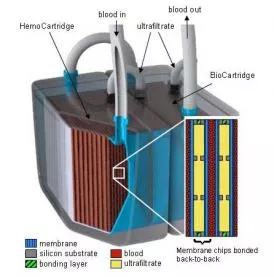The Kidney Project
BioArtificial kidney for end stage renal disease
Principal Investigator: Shuvo Roy, PhD
Challenge
End stage renal disease (ESRD) is the last stage of chronic kidney disease (CKD), in which a patient experiences near complete to total kidney failure. Without functioning kidneys or proper treatment for CKD, patients reaching ESRD will die. Currently, over 650,000 Americans live with ESRD, with over 100,000 on the waiting list for available donor kidneys. Dialysis acts as a short-term treatment for patients waiting for kidney transplantation, but with a shortage of donor organs, the list of patients needing timely and costly dialysis treatments continues to grow. In addition to this clinical issue, those who live with ESRD are only 1% of the U.S. Medicare population, but account for 7% of the Medicare budget.
Solution

The Kidney Project is a national research effort based at UCSF utilizing the talents of a multidisciplinary team of scientists, engineers, and clinicians to tackle ESRD by developing a surgically implanted, free-standing bioartificial kidney. Containing a hemofilter and cell bioreactor, the device acts as a natural kidney by mimicking its metabolic, endocrine, and immunological functions. Powered by blood pressure, the device eliminates the necessity for external tubes or immunosuppressant drugs. The successful development of this device has the potential to extend the lives of patients across the country and ultimately the world.
Funding
National Institutes of Health
National Aeronautics and Space Administration
Department of Defense
Publications
- Humes HD, Buffington D, Westover AJ, Roy S, Fissell WH. The bioartificial kidney: current status and future promise. Pediatr Nephrol. 2014 Mar;29(3):343-51.
- Kim S, Roy S. Microelectromechanical systems and nephrology: the next frontier in renal replacement technology. Adv Chronic Kidney Dis. 2013 Nov;20(6):516-35.
- Olorunsola OG, Kim SH, Chang R, Kuo YC, Hetts SW, Heller A, Kant R, Saeed M, Fissell WH, Roy S, Wilson MW. Imaging assessment of a portable hemodialysis device: detection of possible failure modes and monitoring of functional performance. Med Instrum (Luton). 2014 Mar 27;2(2).
- Kim S, Fissell WH, Humes DH, Roy S. Current strategies and challenges in engineering a bioartificial kidney. Front Biosci (Elite Ed). 2015 Jan 1;7:248-62.
- S. Kim, J. Heller, Z. Iqbal, R. Kant, EJ. Kim, J. Durack, M. Saeed, L. Do, S. Hetts, M. Willson, P. Brakeman, WH. Fissell, S. Roy, "Preliminary Diffusive Clearance of Silicon Nanopore Membranes in a Parallel Plate Configuration for Renal Replacement Therapy," ASAIO Journal, 2016 Mar.
- Diffusive Silicon Nanopore Membranes for Hemodialysis Applications. Kim S, Feinberg B, Kant R, Chui B, Goldman K, Park J, Moses W, Blaha C, Iqbal Z, Chow C, Wright N, Fissell W, Zydney A, Roy S. PLoS One. 2016 Jul 20;11(7):e0159526. PMID: 27438878
- Fissell WH, Roy S, Davenport A. Achieving more frequent and longer dialysis for the majority: wearable dialysis and implantable artificial kidney devices. Kidney Int. 2013 Aug;84(2):256-64.
Featured Media
Largest Kidney Patient Group Backs Artificial Kidney Development - PR Newswire - August 17, 2018
Silicon isn't just for computers. It can make a pretty good kidney, too - Wired - October 6, 2017
Artificial Kidney Research Advances Through UCSF Collaboration - UCSF News - November 3, 2015
